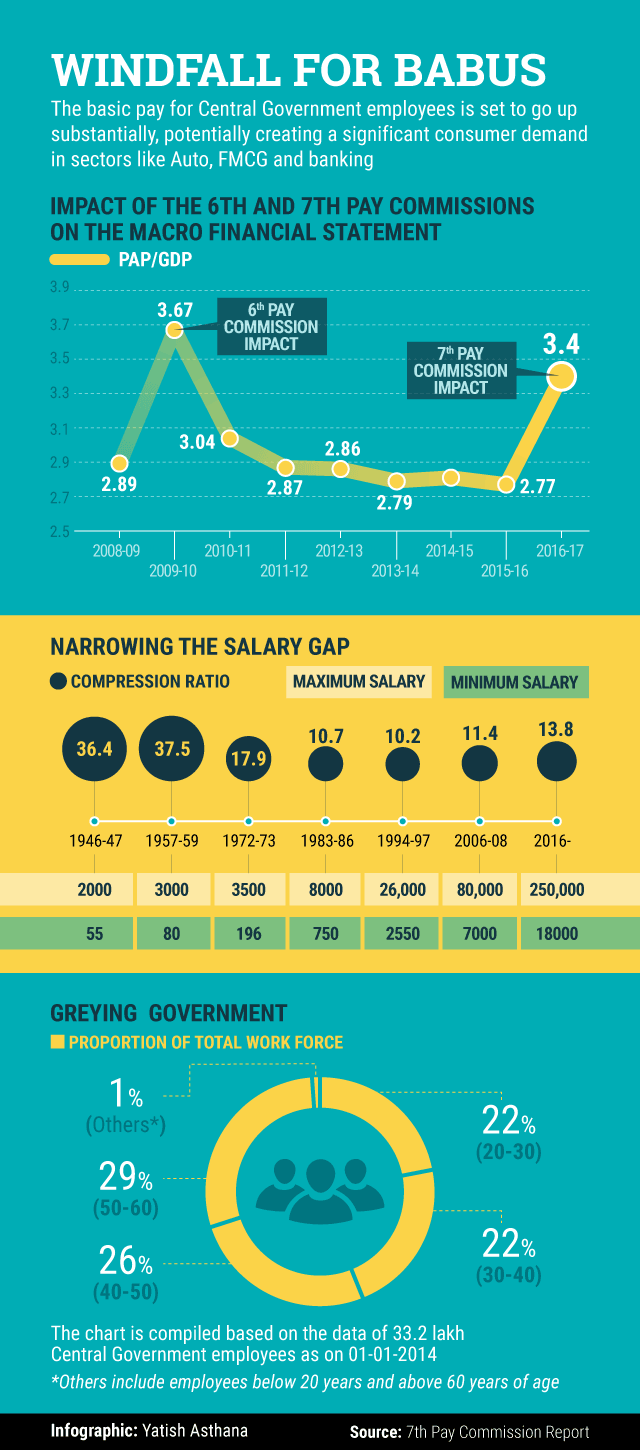The Union Cabinet on Wednesday cleared the recommendations of the seventh central pay panel, a development that will bring cheer for over a crore central government employees and pensioners.
The pay panel had, in November last year, recommended a 14.27% hike in basic pay and a 23.5% increase in salaries and allowances taken together.
Data from the Seventh Central Pay Commission report show that the incremental cost of the recommendations would be of the order of a little over Rs 1 trillion, or 0.7% of gross domestic product (GDP). This could have a significant downstream impact on sectors such as auto, banking, real estate and FMCG. Typically, such pay hikes have led to a spike in auto sales in particular and consumer demand in general.
The central government employs about 50 lakh people, while another 58 lakh pensioners depend on it. While the minimum basic pay will more than double from Rs 7,000 to Rs 18,000 a month, those in the highest pay bracket will see a three-fold increase from Rs 80,000 to Rs 250,000 per month in basic pay.

This is perhaps the lowest hike since independence and will likely have a relatively moderate impact as compared to the sixth pay panel. Following the seventh pay panel’s recommendations, the increase in the ratio of the Pay, Allowances and Pensions (PAP) to that of GDP would be 0.65 percentage points in 2016-17. This is lower than a corresponding increase of 0.77 percentage points in 2009-10, following the sixth pay commission.
The government aims to rein in the fiscal deficit at 3.5% of GDP by 2016-17 and 3% by 2017-18, which it intends to do by bringing down the revenue deficit. This would effectively mean that the size of the government sector as a proportion of GDP would have to stay near constant.
In fact, further perusal of the data shows that even as the total sanctioned strength of the central government hovered around 40 lakh between 2006 and 2014, it only employed 32-33 lakh people during this period.
The report points out that, between 1947 and 1994, the sanctioned strength spiked from a little over 17 lakh to nearly 30 lakh. But corporatisation, especially in the telecom sector, and a decline in the personnel strength of the railways and some other departments has meant that their share in the total employee mix has gone down. Having said that, departments like the home ministry have seen a sharp spike in recruitment during the same period.
Data further show that more than half (55%) the central government employees are in the 40-60 age group while only 44% are 20-40 year olds. This indicates hiring in the last few years has gone down. It also means that a significant proportion of the workforce is set to retire within the next decade.
An analysis of the data also shows that relative income gap between the highest-paid and the lowest-paid government employee has come down since independence. In 1946-47, the highest-paid central government employee earned 36 times that of the lowest-paid employee. After the seventh pay panel, the ratio will be down to just over 13 times. In fact, there was a secular decline in the income gap between 1947 and 1997, when the recommendations of the fifth pay commission were implemented. Recent years have, however, seen a slight uptrend.
Like this report? Sign up for our daily newsletter to get our top reports.







